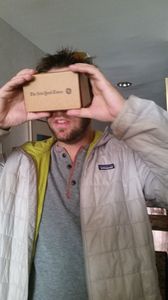This weekend my New York Times subscription came with a little something extra -- the Cracker Jack's prize for newsreaders. I was one of the million chosen to receive Google Cardboard (a low-cost virtual reality viewer) with my Sunday paper.
Google Cardboard (pictured below) is the poor man's version of the expensive diving-goggle shaped VR helmets like Oculus Rift and Epson Moverio. But Cardboard operates in a pretty low-tech way, much like the old View Master you may have used as a kid. The Cardboard viewer has two lenses that focus on a split-screen image. Your eyes and brain do some converge magic to meld the two different images into a single 3D image.

But the real magic comes from the content being delivered over your own mobile phone which you insert into the cardboard like a mini movie theater. The images have been captured not by one camera, but by a ring of cameras that record in 360 degrees so your experience is like walking into a story. As you turn your head or gaze at the floor, you experience what each of those cameras captured, depending on where you look. Turn your head, look up, look down, spin around and your eyes see an immersive story unfold.
After the origami-like folds that created our Cardboard, we downloaded the special app and inserted the phone. We plugged a set of headphones in and were transported into the stories of three displaced children --- refugees from Ukraine, Lebanon and South Sudan.
The first images we saw were of a bombed out schoolhouse in the Ukraine. From the crumbled walls and concrete slabs, to the shreds of old paper and books, and overturned desks and chairs, I could follow Oleg, a displaced-by-war 11-year-old as he documented his return to his war-torn home.
My son, mom, and husband all took turns taking Cardboard for a spin. Unanimous were the wow's and oh my's that ensued. There we were paddling through a crocodile-infested swamp with Chul and picking crops in the fields with Hana. We saw what they saw every day.
Sure, after the initial impact of walking through a story in 3D, we all wished there was more to the story. Did we have any more emotional ties to displaced kids? Did we know any more about where Sudan was? Did we have a million questions better answered the magazine's print edition? You bet. Did we wish we didn't have to insert and reinsert the phone into the box each time we wanted to start her up? Do we wish it didn't drain phone batteries? You bet as well.
I asked everyone I saw today what they thought of their virtual reality experience. Two folks made me wince when they admitted that they'd simply thrown the cardboard out. A few others expected a more poignant experience. Some argued that a cardboard boxed version of VR would doom it by selling it short. As for my household, we were grateful to see the potential in another way to tell the story. NY Times, Google and the other partners that helped create film and distribute get a hearty thanks for bringing a taste of VR to the people.
Robin Raskin is founder of Living in Digital Times (LIDT), a team of technophiles who bring together top experts and the latest innovations that intersect lifestyle and technology. LIDT produces conferences and expos at CES and throughout the year focusing on how technology enhances every aspect of our lives through the eyes of today's digital consumer.
